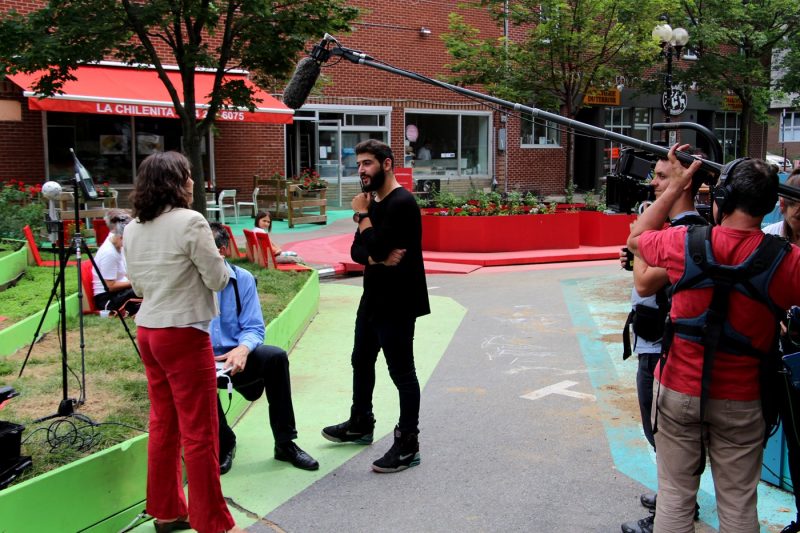by Christine Kerrigan
On Friday, November 17, Télé Québec aired a TV spot on their show Électrons Libres featuring the research and work of the Sounds in the City team at McGill University. Dr. Catherine Guastavino, principal investigator for the team, walked Télé-Québec commentator, Rabi Rammal, through some recent research the team has been conducting for a newly designed pedestrian zone on Roy Street in the Plateau Mont-Royal neighborhood of Montréal. The interview then migrated to the team’s lab facilities at McGill’s Center for Interdisciplinary Research in Music, Media and Technology (CIRMMT), where Guastavino demonstrated some of the team’s capabilities for recreating urban sound environments using sound simulation technologies. The paragraphs that follow provide a short summary of some of the key themes and topics discussed during the interview.
Host Rabi Rammal visited the Roy Street pedestrian site where Guastavino explained her team’s work in psychoacoustics, the study of how people perceive their sound environments. The nature of this living lab necessitates working closely with the City and design teams, in order to ensure that sound is taken into account from the early phases of an urban design project. In the case of the Roy Street pedestrian zone, the research team conducted surveys with roughly 100 users of the space to learn how the sound environment is being perceived. Rammal took the same survey on-the-spot in order to better understand the type of information the team is interested in gathering. The discussions then revolved around the next phase of the project – capturing the sound at several different times of the day and week using sound level meters (to get decibel levels) and ambisonic[1] microphones.
The Télé Québec team then accompanied Guastavino to her sound lab at McGill, where she demonstrated how her team can reproduce the sounds they’d just recorded in the pedestrian zone with advanced software and multiple speakers placed at several locations in the sound-proof laboratory. The researchers illustrated how sound levels can be modified and new sound sources can be added, such as the sounds of a water fountain or additional traffic sounds. Rammal, yet again, took a questionnaire to describe his experience in this virtually modified sound environment. By listening to the difference of adding water fountain sounds versus traffic noises, Rammal discovered that our perception of sound is far more complex than what a decibel reading can convey. Due to the presence of many sound sources, the soundscape became more layered and complex, and some sounds masked others.
Guastavino explained that the information gathered from participants at the Roy Street site will be analyzed and the team will make recommendations to the City of Montréal for the next phase of the pedestrian project, which is planned for the summer of 2018. The interview concluded with the Electron Libres team highlighting that it’s the first time a city is attempting to take a more proactive approach, where urban sound considerations are taken into account in the conceptual phases of urban design projects.
To watch the full interview (in French), please visit:
https://electronslibres.telequebec.tv/episodes/35418
[1] A complete 3-D audio recording technique: https://en.wikipedia.org/wiki/Ambisonics
